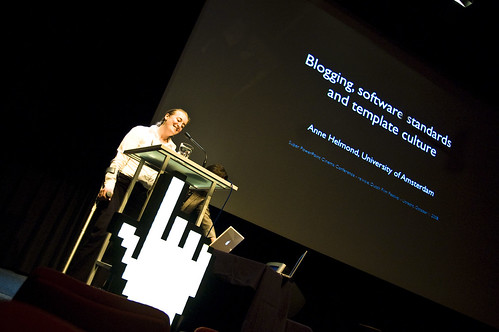Last week I gave a lecture on ‘Blogging, software standards and template culture’ at the Dutch Film Festival at the SuperPowerPointCinema mini-conference with Bruce Sterling and Eboman organized by Mieke Gerritzen and Koert van Mensvoort.
I do not have a transcript of the actual presentation (which included a few improvised extras) but here are my prepared notes:
1. Blogging, software standards and template culture
Thank you very much for inviting me. My name is Anne Helmond and I am a New Media Lecturer at the University of Amsterdam where I conduct research with the Digital Methods Initiative within the emerging field of Software Studies.
2. The “new†media effect: Software Studies // Software Culture // Template Culture
This SuperPowerPoint Cinema mini conference is part of the re:vision2008 series titled ‘The New Media Effect’ which aims to address important questions including
- Is there such a thing as a language of new media &
- Does this lead to a new image aesthetics?
Lev Manovich addressed the first question in his book, appropriately titled, The Language of New Media (2001) in which he argued that new media does have its own distinctive language, or rather distinctive languages. He states that media have become programmable and that we need a new field of study to address the issues that arise from this turn in our culture. Not only has software quietly penetrated our daily life but it has also become invisible. The ubiquity and so-called transparency of software renders it invisible but at the same time it points out the importance of studying it. ‘’From media studies, we move to something that can be called “software studies” — from media theory to software theory.’’
3. Software Studies
Our current society is penetrated by and shaped by software and should thus be subject to appropriate critique. The ubiquity of software has led to a software culture and we are now living in a software society. What does it mean to live in such a software society instead of an industrial society? A world which is created by software is opaque and that is why we need to study software.
4. Software Culture
“We live in a software culture – that is, a culture where the production, distribution, and reception of most content is mediated by software.†Manovich
Software has become a cultural force….
5. Template Culture
The language of new media produces new visual aesthetics which are clearly visible in what I would propose to call a Template Culture.
This Template Culture is especially visible in popular Content Management Systems such as Joomla, Drupal and the blog software WordPress. The aesthetics of the content created within these systems are based on software standards, default settings, themes and templates.
6. Defaults
Templates define or reinforce a certain aspects of software culture as a culture is shaped by its medium and practice. What do templates say about the medium and practice of blogging? The WordPress default theme points to the ‘easy publishing’ model of blog software which supposedly no longer required HTML knowledge to publish online. However, it also implies that you don’t know how to change the adjust the stylesheet and code or change the software settings to escape the default. One blogger thus ironically named his blog “Default Settings.â€
7. h4ck3r
The practice of blogging changed with the introduction of blog software as coding knowledge is no longer required. Easy-to-use blog software introduced the practice of blogging —that previously belonged to (semi) tech-savvy web users— to the ‘average’ web user. However, customizing the blog requires a move back to code. Subverting the defaults requires CSS and PHP skills.
8. Database aesthetics
The blog, blog software and the blog theme act as an interface to the underlying database where the blog posts and some of the content is stored. A theme determines which content is retrieved and where it is displayed.
If we see the blog as a database we can also see theme hacks that focus on the database. This means that we can build themes that retrieve the information in the database in different ways that defy the regular blog structure of reverse-chronological order and its accompanying aesthetics.
9. Widgets and plugins
This is an exceptional hacked customized WordPress theme. According many researchers within the field of Software Studies hacking plays an important part in opening up our understanding of software.
However, if we want to look at the common web user to make sense of software culture on the web we should take a different approach. Most of us who use and study software don’t hack, we are part of the template culture. We are defined and restrained by templates in which dragging and dropping widgets offer a small degree of personalization.
10. The Widgetized Self
Widgets are pieces of code that you can drag and drope into your template and have become a popular way of ‘accessorizing’ and personalizing the blog. Widgets are used to embed the scattered self into one place, the blog, creating ‘the widgetized self’ (Baym, 2007). Small customizations and modifications in the backend of the blog are a major practice within the blogosphere.
On the web, the practices of the drag-and-drop and modding user show the workings of a template culture as an important part of software culture.
11. Thank you! Questions?

2 thoughts on “Slides and notes from my presentation on Blogging, Software Standards and Template Culture”